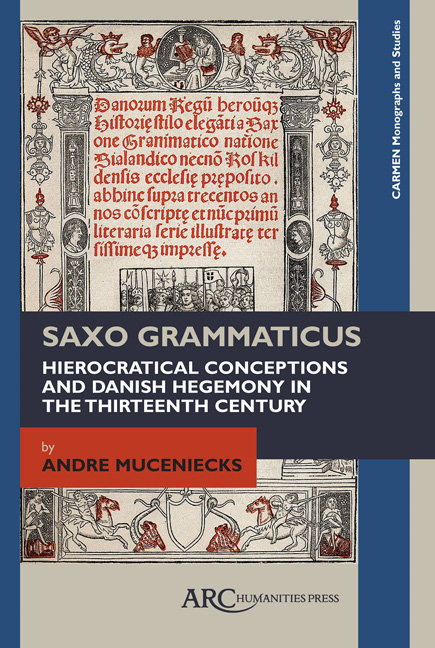Book contents
- Frontmatter
- Contents
- List of Illustrations
- Acknowledgements
- Foreword
- Preface
- Chapter 1 Denmark and the Baltic in the Thirteenth Century
- Chapter 2 The Work
- Chapter 3 Political Conceptions
- Chapter 4 Euhemerism and the East in Saxo Grammaticus
- Chapter 5 Virtues and Values in Saxo Grammaticus: The Four Cardinal Virtues
- Chapter 6 The Thematic of the Counsellor
- Conclusion
- Appendix 1 List of the Kings in Books I–VIII of the Gesta Danorum
- Appendix 2 Rulers and Archbishops of Denmark in Relation to Events in the Baltic, the Empire, and the Papacy
- Appendix 3 Genealogy of the Valdemarian Kings
- Bibliography
- Index of Persons
- Index of Places and Peoples
- Index of Authors and Primary Sources
- Index of Subjects
Chapter 1 - Denmark and the Baltic in the Thirteenth Century
Published online by Cambridge University Press: 15 January 2021
- Frontmatter
- Contents
- List of Illustrations
- Acknowledgements
- Foreword
- Preface
- Chapter 1 Denmark and the Baltic in the Thirteenth Century
- Chapter 2 The Work
- Chapter 3 Political Conceptions
- Chapter 4 Euhemerism and the East in Saxo Grammaticus
- Chapter 5 Virtues and Values in Saxo Grammaticus: The Four Cardinal Virtues
- Chapter 6 The Thematic of the Counsellor
- Conclusion
- Appendix 1 List of the Kings in Books I–VIII of the Gesta Danorum
- Appendix 2 Rulers and Archbishops of Denmark in Relation to Events in the Baltic, the Empire, and the Papacy
- Appendix 3 Genealogy of the Valdemarian Kings
- Bibliography
- Index of Persons
- Index of Places and Peoples
- Index of Authors and Primary Sources
- Index of Subjects
Summary
Kingship, Royal Succession and Stability
The Gesta Danorum was written in the apogee of the Valdemarian dynasty (ca. 1157–1241). An epoch responsible, among other achievements, for bringing remarkable stability to the kingdom of Denmark after ages of civil strife. Although the country had gone through the earliest unification process amidst the Scandinavian nations, in most of the sources what is represented as “king of the Danes” was most likely a “king” of adjacent regions such as Jylland, Sjælland, or Skåne.
The first Danish king to be baptized was Harald Klak, in the year 826. However, the monarch acclaimed as responsible for unifying Denmark was Harald Bluetooth, in around 965; therefore, what is presented as “king” in certain sources was more precisely an overlord of particular Danish regions or islands.
The scarcity of primary sources related to the first years of the Danish realm makes the task of tracing an accurate chronological line a hard one. That is not our purpose, notwithstanding. To assert the hardships faced in the midst of succession disputes is enough; the Annales regni Francorum, for instance, refers to the necessity of restoration of the Danish authority in 813, after the death of King Godfred in 810.
Certainly, the circumstance was not rare or isolated. A few rulers were able to unify the kingdom and even expand it to the neighbouring Scandinavian nations, but immediately after their death turbulence would return, bringing several years of struggle between pretenders, until one of them became strong enough to ascend to the throne and re-establish order.
Doubtless the lack of clear procedures concerning royal succession, at least as relates to hereditary transfer, had a large share of responsibility for this situation. The primary criterion in appointing a king was his election by the þingr. There was no tradition of primogeniture or similar. The only parameter to be considered was the claimants’ membership of the family of the deceased king.
In this way, each son had exactly the same right to succession, and even distant relatives would be willing to claim the throne.
- Type
- Chapter
- Information
- Saxo GrammaticusHierocratical Conceptions and Danish Hegemony in the Thirteenth Century, pp. 1 - 28Publisher: Amsterdam University PressPrint publication year: 2017



